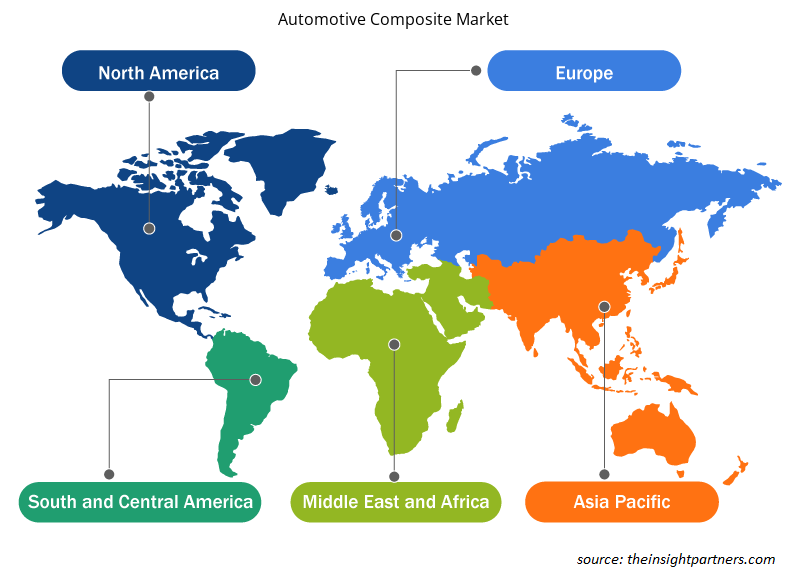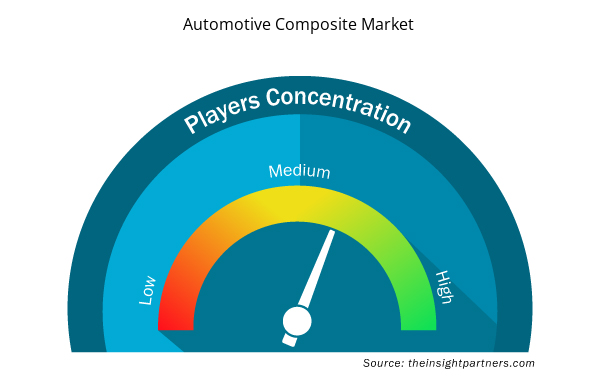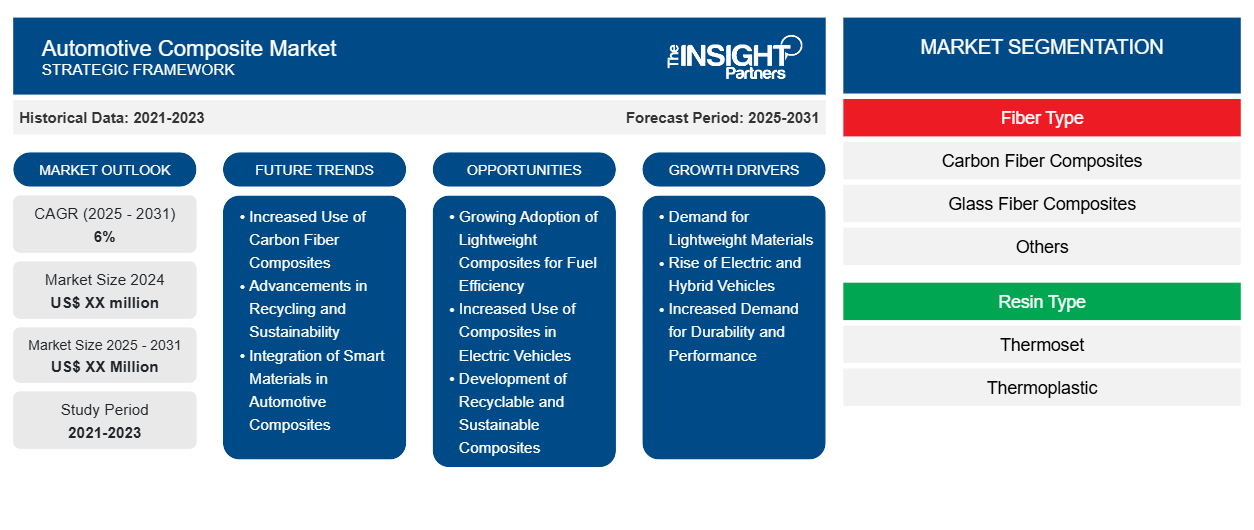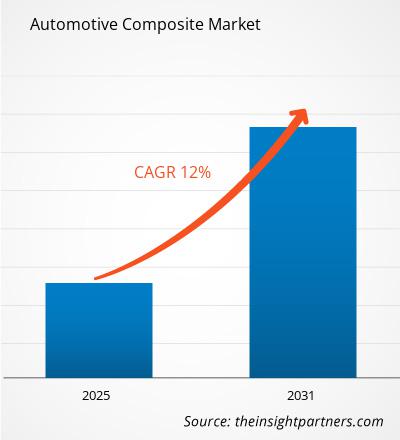自動車用複合材料市場は、2023年から2031年にかけて6%のCAGRを記録し、市場規模は2023年のXX百万米ドルから2031年にはXX百万米ドルに拡大すると予想されています。
レポートは、繊維タイプ(炭素繊維複合材、ガラス繊維複合材、その他)別にセグメント化されています。レポートではさらに、樹脂タイプ(熱硬化性樹脂(ポリエステル、ビニルエステル、エポキシ、ポリウレタン、その他)、熱可塑性樹脂(ポリプロピレン、ポリエチレン、ポリ塩化ビニル、ポリスチレン、ポリエチレンテレフタレート、ポリカーボネート、その他)に基づく分析を提示しています。車両タイプに基づいて、レポートは(乗用車、小型商用車(LCV)、大型商用車、二輪車、その他)に分類されています。グローバル分析は、地域レベルと主要国でさらに細分化されています。レポートは、上記の分析とセグメントに対してUSDでの値を提供します。
報告書の目的
The Insight Partners のレポート「自動車用複合材市場」は、現在の状況と将来の成長、主な推進要因、課題、機会を説明することを目的としています。これにより、次のようなさまざまなビジネス関係者に洞察が提供されます。
- テクノロジープロバイダー/メーカー: 進化する市場の動向を理解し、潜在的な成長機会を把握することで、情報に基づいた戦略的意思決定が可能になります。
- 投資家: 市場の成長率、市場の財務予測、バリュー チェーン全体に存在する機会に関する包括的な傾向分析を実施します。
- 規制機関: 市場の濫用を最小限に抑え、投資家の信用と信頼を維持し、市場の完全性と安定性を維持することを目的として、市場における政策と警察活動を規制します。
自動車用複合材料市場のセグメンテーション
繊維の種類
- 炭素繊維複合材料
- ガラス繊維複合材料
- その他
樹脂タイプ
- 熱硬化性
- 熱可塑性
要件に合わせてレポートをカスタマイズする
このレポートの一部、国レベルの分析、Excelデータパックなど、あらゆるレポートを無料でカスタマイズできます。また、スタートアップや大学向けのお得なオファーや割引もご利用いただけます。
- このレポートの主要な市場動向を入手してください。この無料サンプルには、市場動向から見積もりや予測に至るまでのデータ分析が含まれます。
自動車用複合材市場の成長要因
- 軽量素材の需要: 自動車業界では、燃費向上と排出量削減のため、車両の軽量化にますます力を入れています。炭素繊維強化プラスチックやガラス繊維複合材などの自動車用複合材は、強度や耐久性を損なうことなく軽量化を実現します。ボディパネル、シャーシ、内装への使用が加速しています。
- 電気自動車とハイブリッド車の台頭: バッテリーの性能と走行距離を最大限に高めるために軽量素材を必要とする電気自動車 (EV) とハイブリッド車の人気の高まりにより、自動車用複合材の需要が高まっています。これらの素材は、強度と重量の比率を高め、全体的なエネルギー効率の向上に役立ちます。
- 耐久性と性能に対する需要の高まり: 自動車用複合材は、耐久性、耐腐食性、過酷な環境条件に耐える能力で知られています。車両の技術が進歩するにつれて、軽量で耐腐食性があり、コスト効率に優れながら高性能な材料に対する需要が高まり続けています。
自動車複合材市場の将来動向
- 炭素繊維複合材の使用増加: 自動車メーカーが燃費向上と車両重量の削減に注力するにつれて、炭素繊維複合材はより広く普及すると予想されます。これらの材料は、特に電気自動車、高級車、高性能スポーツ車両において、強度と重量の比が非常に高く、車両性能とエネルギー効率を向上させます。
- リサイクルと持続可能性の進歩: 自動車用複合材の将来は、複合材料のリサイクル性の向上に重点が置かれるでしょう。環境問題と廃棄物の削減がますます重要になる中、リサイクルが容易でより持続可能な複合材料の開発は、自動車部門の成長を促進するでしょう。
- 自動車用複合材へのスマート材料の統合: 自己修復特性、センサー、その他の統合機能を備えたスマート複合材の登場により、自動車業界に革命が起こると予想されています。これらの材料により、車両の状態を監視し、軽微な損傷を修復し、車両全体の性能を向上させることが可能になり、耐久性の向上とメンテナンスコストの削減につながります。
自動車用複合材料市場の機会
- 燃費向上のための軽量複合材の採用拡大: 自動車メーカーが燃費向上に注力する中、カーボンファイバーやグラスファイバーなどの軽量複合材は重要な市場機会となります。これらの材料は、車体部品、シャーシ、内装部品に統合され、重量の軽減、性能の向上、規制排出目標の達成に役立っています。
- 電気自動車における複合材料の使用増加: 電気自動車 (EV) への移行は、自動車用複合材料市場に大きなチャンスをもたらします。EV では、バッテリーの走行距離と効率を最大限に高めるために軽量素材が必要であり、複合材料はこの目的に最適です。EV の生産が増加するにつれて、バッテリー ハウジング、構造部品、内装部品などの分野で高度な複合材料の需要が高まります。
- リサイクル可能で持続可能な複合材料の開発: 持続可能性への重点が高まるにつれて、リサイクル可能で環境に優しい自動車用複合材料の市場が拡大しています。メーカーは、性能と環境の両方の要件を満たすバイオベースの複合材料とリサイクル可能な材料で革新を進めており、グリーン自動車部門に有利な機会を提供しています。
自動車用複合材市場の地域別分析
予測期間を通じて自動車複合材市場に影響を与える地域的な傾向と要因は、Insight Partners のアナリストによって徹底的に説明されています。このセクションでは、北米、ヨーロッパ、アジア太平洋、中東およびアフリカ、南米および中米にわたる自動車複合材市場のセグメントと地理についても説明します。

- 自動車複合材市場の地域別データを入手
自動車複合材料市場レポートの範囲
| レポート属性 | 詳細 |
|---|---|
| 2023年の市場規模 | XX百万米ドル |
| 2031年までの市場規模 | XX百万米ドル |
| 世界のCAGR(2023年~2031年) | 6% |
| 履歴データ | 2021-2022 |
| 予測期間 | 2024-2031 |
| 対象セグメント | 繊維の種類別
|
| 対象地域と国 | 北米
|
| 市場リーダーと主要企業プロフィール |
|
自動車用複合材市場のプレーヤー密度:ビジネスダイナミクスへの影響を理解する
自動車複合材市場は、消費者の嗜好の変化、技術の進歩、製品の利点に対する認識の高まりなどの要因により、エンドユーザーの需要が高まり、急速に成長しています。需要が高まるにつれて、企業は提供を拡大し、消費者のニーズを満たすために革新し、新たなトレンドを活用し、市場の成長をさらに促進しています。
市場プレーヤー密度とは、特定の市場または業界内で活動している企業または会社の分布を指します。これは、特定の市場スペースに、その規模または総市場価値と比較して、どれだけの競合相手 (市場プレーヤー) が存在するかを示します。
自動車複合材市場で事業を展開している主要企業は次のとおりです。
- 東レ株式会社
- SGLカーボン
- 帝人株式会社
- 三菱ケミカル株式会社。
- ヘクセル株式会社
免責事項:上記の企業は、特定の順序でランク付けされていません。

- 自動車複合材市場のトップキープレーヤーの概要を入手
主なセールスポイント
- 包括的なカバレッジ: レポートでは、自動車用複合材料市場の製品、サービス、タイプ、エンドユーザーの分析を包括的にカバーし、全体的な展望を提供します。
- 専門家による分析: レポートは、業界の専門家とアナリストの深い理解に基づいてまとめられています。
- 最新情報: このレポートは、最新の情報とデータの傾向を網羅しているため、ビジネスの関連性を保証します。
- カスタマイズ オプション: このレポートは、特定のクライアント要件に対応し、ビジネス戦略に適切に適合するようにカスタマイズできます。
したがって、自動車複合材市場に関する調査レポートは、業界のシナリオと成長の見通しを解読し理解する道の先導役となることができます。いくつかの正当な懸念があるかもしれませんが、このレポートの全体的な利点は欠点を上回る傾向があります。
- 過去2年間の分析、基準年、CAGRによる予測(7年間)
- PEST分析とSWOT分析
- 市場規模価値/数量 - 世界、地域、国
- 業界と競争環境
- Excel データセット



Report Coverage
Revenue forecast, Company Analysis, Industry landscape, Growth factors, and Trends

Segment Covered
This text is related
to segments covered.

Regional Scope
North America, Europe, Asia Pacific, Middle East & Africa, South & Central America

Country Scope
This text is related
to country scope.
よくある質問
DuPont de Nemours Inc, Gurit Holding AG, Hexion Inc, Mitsubishi Chemical Holdings Corp, Nippon Electric Glass Co Ltd, Owens Corning are some of the key players operating in the automotive composites market
Based on geography, Asia Pacific held the largest share of the automotive composites market due to the well-established automotive industry across the region
Increased use of carbon fiber composites is expected to be the key market trends.
Based on fiber type, the carbon fiber segment is expected to witness the fastest growth during the forecast period
The Automotive Composite Market is estimated to witness a CAGR of 12.0% from 2025 to 2031
Demand for lightweight materials is driving the automotive composites market growth.
Trends and growth analysis reports related to Chemicals and Materials : READ MORE..
The List of Companies
- Toray Industries Inc.
- SGL Carbon
- TEIJIN LIMITED
- Mitsubishi Chemical Corporation.
- Hexcel Corporation
- John Manville Corporation
- Owens Corning
- Zoltek Carbon Fiber
- Cytec Solvay Group
- Gurit
The Insight Partners performs research in 4 major stages: Data Collection & Secondary Research, Primary Research, Data Analysis and Data Triangulation & Final Review.
- Data Collection and Secondary Research:
As a market research and consulting firm operating from a decade, we have published and advised several client across the globe. First step for any study will start with an assessment of currently available data and insights from existing reports. Further, historical and current market information is collected from Investor Presentations, Annual Reports, SEC Filings, etc., and other information related to company’s performance and market positioning are gathered from Paid Databases (Factiva, Hoovers, and Reuters) and various other publications available in public domain.
Several associations trade associates, technical forums, institutes, societies and organization are accessed to gain technical as well as market related insights through their publications such as research papers, blogs and press releases related to the studies are referred to get cues about the market. Further, white papers, journals, magazines, and other news articles published in last 3 years are scrutinized and analyzed to understand the current market trends.
- Primary Research:
The primarily interview analysis comprise of data obtained from industry participants interview and answers to survey questions gathered by in-house primary team.
For primary research, interviews are conducted with industry experts/CEOs/Marketing Managers/VPs/Subject Matter Experts from both demand and supply side to get a 360-degree view of the market. The primary team conducts several interviews based on the complexity of the markets to understand the various market trends and dynamics which makes research more credible and precise.
A typical research interview fulfils the following functions:
- Provides first-hand information on the market size, market trends, growth trends, competitive landscape, and outlook
- Validates and strengthens in-house secondary research findings
- Develops the analysis team’s expertise and market understanding
Primary research involves email interactions and telephone interviews for each market, category, segment, and sub-segment across geographies. The participants who typically take part in such a process include, but are not limited to:
- Industry participants: VPs, business development managers, market intelligence managers and national sales managers
- Outside experts: Valuation experts, research analysts and key opinion leaders specializing in the electronics and semiconductor industry.
Below is the breakup of our primary respondents by company, designation, and region:

Once we receive the confirmation from primary research sources or primary respondents, we finalize the base year market estimation and forecast the data as per the macroeconomic and microeconomic factors assessed during data collection.
- Data Analysis:
Once data is validated through both secondary as well as primary respondents, we finalize the market estimations by hypothesis formulation and factor analysis at regional and country level.
- Macro-Economic Factor Analysis:
We analyse macroeconomic indicators such the gross domestic product (GDP), increase in the demand for goods and services across industries, technological advancement, regional economic growth, governmental policies, the influence of COVID-19, PEST analysis, and other aspects. This analysis aids in setting benchmarks for various nations/regions and approximating market splits. Additionally, the general trend of the aforementioned components aid in determining the market's development possibilities.
- Country Level Data:
Various factors that are especially aligned to the country are taken into account to determine the market size for a certain area and country, including the presence of vendors, such as headquarters and offices, the country's GDP, demand patterns, and industry growth. To comprehend the market dynamics for the nation, a number of growth variables, inhibitors, application areas, and current market trends are researched. The aforementioned elements aid in determining the country's overall market's growth potential.
- Company Profile:
The “Table of Contents” is formulated by listing and analyzing more than 25 - 30 companies operating in the market ecosystem across geographies. However, we profile only 10 companies as a standard practice in our syndicate reports. These 10 companies comprise leading, emerging, and regional players. Nonetheless, our analysis is not restricted to the 10 listed companies, we also analyze other companies present in the market to develop a holistic view and understand the prevailing trends. The “Company Profiles” section in the report covers key facts, business description, products & services, financial information, SWOT analysis, and key developments. The financial information presented is extracted from the annual reports and official documents of the publicly listed companies. Upon collecting the information for the sections of respective companies, we verify them via various primary sources and then compile the data in respective company profiles. The company level information helps us in deriving the base number as well as in forecasting the market size.
- Developing Base Number:
Aggregation of sales statistics (2020-2022) and macro-economic factor, and other secondary and primary research insights are utilized to arrive at base number and related market shares for 2022. The data gaps are identified in this step and relevant market data is analyzed, collected from paid primary interviews or databases. On finalizing the base year market size, forecasts are developed on the basis of macro-economic, industry and market growth factors and company level analysis.
- Data Triangulation and Final Review:
The market findings and base year market size calculations are validated from supply as well as demand side. Demand side validations are based on macro-economic factor analysis and benchmarks for respective regions and countries. In case of supply side validations, revenues of major companies are estimated (in case not available) based on industry benchmark, approximate number of employees, product portfolio, and primary interviews revenues are gathered. Further revenue from target product/service segment is assessed to avoid overshooting of market statistics. In case of heavy deviations between supply and demand side values, all thes steps are repeated to achieve synchronization.
We follow an iterative model, wherein we share our research findings with Subject Matter Experts (SME’s) and Key Opinion Leaders (KOLs) until consensus view of the market is not formulated – this model negates any drastic deviation in the opinions of experts. Only validated and universally acceptable research findings are quoted in our reports.
We have important check points that we use to validate our research findings – which we call – data triangulation, where we validate the information, we generate from secondary sources with primary interviews and then we re-validate with our internal data bases and Subject matter experts. This comprehensive model enables us to deliver high quality, reliable data in shortest possible time.


 このレポートの無料サンプルを入手する
このレポートの無料サンプルを入手する